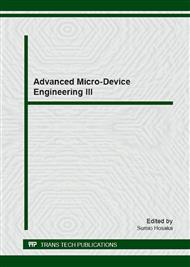p.71
p.76
p.82
p.88
p.93
p.99
p.107
p.113
p.118
Analysis of Electrical Property of the Animal Cell Using Dielectrophoresis Levitation
Abstract:
In order to clarify the relation between ReKω and the electrical property of each intracellular part, we loaded temperature stress on the cells. In this experiment, the electrical property of the intracellular part means the cytoplasm electrical conductivity (σ3) and the cell membrane capacitance (Cm). ReKω of the cells was measured using dielectrophoresis (DEP) levitation, and the electrical property of each intracellular part was analyzed from the measurement result in applying a single shell model. In this experiment, mouse hybridoma 3-2H3 cells were used as the sample cells. Temperature stress was loaded on the sample cell at 5% CO2 in a CO2 incubator. The result of the frequency characteristic of ReKω using DEP levitation showed that both ReKω and the crossover frequency of the single cell in the high frequency region decreased with increasing temperature. Furthermore, both the cytoplasm electrical conductivity and the cell membrane capacitance decreased with increasing temperature stress.
Info:
Periodical:
Pages:
93-98
Citation:
Online since:
January 2013
Authors:
Keywords:
Price:
Сopyright:
© 2013 Trans Tech Publications Ltd. All Rights Reserved
Share:
Citation:


